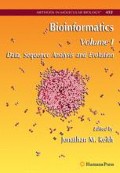Abstract
Most alternative splicing events in human and other eukaryotic genomes are detected using sequence fragments produced by high throughput genomic technologies, such as EST sequencing and oligonu-cleotide microarrays. Reconstructing full-length transcript isoforms from such sequence fragments is a major interest and challenge for computational analyses of pre-mRNA alternative splicing. This chapter describes a general graph-based approach for computational inference of full-length isoforms.
Access this chapter
Tax calculation will be finalised at checkout
Purchases are for personal use only
References
Boue, S., Vingron, M., Kriventseva, E., et al. (2002) Theoretical analysis of alternative splice forms using computational methods. Bioinformatics 18 Suppl 2, S65–S73.
Lee, C., Wang, Q. (2005) Bioinformatics analysis of alternative splicing. Brief Bioin-form 6, 23–33.
Heber, S., Alekseyev, M., Sze, S. H., et al. (2002) Splicing graphs and EST assembly problem. Bioinformatics 18 Suppl. 1, S181–188.
Blencowe, B. J. (2006) Alternative splicing: new insights from global analyses. Cell 126, 37–47.
Xing, Y., Resch, A., Lee, C. (2004) The Multiassembly Problem: reconstructing multiple transcript isoforms from EST fragment mixtures. Genome Res 14, 426–441.
Leipzig, J., Pevzner, P., Heber, S. (2004) The Alternative Splicing Gallery (ASG): bridging the gap between genome and transcriptome. Nucleic Acids Res 32, 3977–3983.
Eyras, E., Caccamo, M., Curwen, V., et al. (2004) ESTGenes: alternative splicing from ESTs in Ensembl. Genome Res 14, 976–987.
Kim, P., Kim, N., Lee, Y., et al. (2005) ECgene: genome annotation for alternative splicing. Nucleic Acids Res 33, D75–79.
Lee, B. T., Tan, T. W., and Ranganathan, S. (2004) DEDB: a database of Drosophila melanogaster exons in splicing graph form. BMC Bioinformatics 5, 189.
Florea, L., Di Francesco, V., Miller, J., et al. (2005) Gene and alternative splicing annotation with AIR. Genome Res 15, 54–66.
Xing, Y., Yu, T., Wu, Y. N., et al. (2006) An expectation-maximization algorithm for probabilistic reconstructions of full-length isoforms from splice graphs. Nucleic Acids Res 34, 3150–3160.
Lee, C. (2003) Generating consensus sequences from partial order multiple sequence alignment graphs. Bioinformatics 19, 999–1008.
Maquat, L. E. (2004) Nonsense-mediated mRNA decay: splicing, translation and mRNP dynamics. Nat Rev Mol Cell Biol 5, 89–99.
Resch, A., Xing, Y., Modrek, B., et al. (2004) Assessing the impact of alternative splicing on domain interactions in the human pro-teome. J Proteome Res 3, 76–83.
Xing, Y., Xu, Q., Lee, C. (2003) Widespread production of novel soluble protein isoforms by alternative splicing removal of transmembrane anchoring domains. FEBS Lett 555, 572–578.
Malde, K., Coward, E., Jonassen, I. (2005) A graph based algorithm for generating EST consensus sequences. Bioinformatics 21, 1371–1375.
Lee, C., Atanelov, L., Modrek, B., et al. (2003) ASAP: The Alternative Splicing Annotation Project. Nucleic Acids Res 31, 101–105.
Acknowledgments
This work was funded by a Dreyfus Foundation Teacher-Scholar Award to C.J.L., and by the National Institutes of Health through the NIH Roadmap for Medical Research, Grant U54 RR021813 entitled Center for Computational Biology (CCB). Information on the National Centers for Biomedical Computing can be obtained from http://nihroadmap.nih.gov/bioinformatics.
Author information
Authors and Affiliations
Editor information
Editors and Affiliations
Rights and permissions
Copyright information
© 2008 Humana Press, a part of Springer Science+Business Media, LLC
About this protocol
Cite this protocol
Xing, Y., Lee, C. (2008). Reconstruction of Full-Length Isoforms from Splice Graphs. In: Keith, J.M. (eds) Bioinformatics. Methods in Molecular Biology™, vol 452. Humana Press. https://doi.org/10.1007/978-1-60327-159-2_10
Download citation
DOI: https://doi.org/10.1007/978-1-60327-159-2_10
Publisher Name: Humana Press
Print ISBN: 978-1-58829-707-5
Online ISBN: 978-1-60327-159-2
eBook Packages: Springer Protocols

